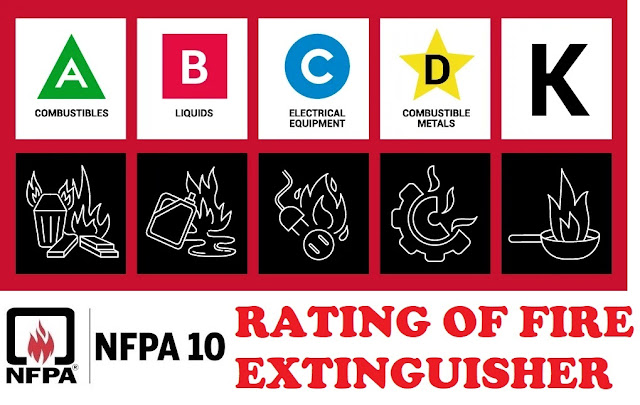Fire
Extinguisher Ratings
Fire extinguishers are
often the first line of defense when it comes to stopping fires while they are
still small.
A key component of
successfully using an extinguisher is ensuring the type of extinguisher is a
match for the type of fire.
There is the risk of
spreading a fire if you use the wrong extinguisher, this is one of the reasons
we only recommend that only those who are trained use extinguishers.
Numerical fire ratings
on fire extinguishers are standardized and help users select the appropriate
extinguisher for specific fire hazards.
Here's how numerical ratings typically work for different classes of fires:
Class A
Class A fires are those
that involve ordinary combustible materials such as wood, cloth, paper, rubber,
and many plastics.
So, when you see a fire
extinguisher with a class A rating then you know it can safely put out a fire
made of ordinary combustibles.
The numerical rating
for Class A fires indicates the equivalent extinguishing capability in terms of
water.
For example: A 2A
rating means the extinguisher has the equivalent extinguishing power of 2.5
gallons of water.
A 4A rating would
indicate it has the equivalent power of 5 gallons of water. Higher numbers
signify greater effectiveness against Class A fires.
Example: A fire
extinguisher with a 3A rating can effectively extinguish a fire involving
ordinary combustibles, such as wood or paper, with the power equivalent of 3.75
gallons of water.
WORK AT HEIGHT PRECAUTIONS - PICTORIAL TRAINING ( 2 )
Class B
Extinguishers with a
Class B rating are designed to be used on fires that involve flammable liquids
and gases (think oil-based paint, alcohol, gasoline etc.).
Class B rated
extinguishers also have a number associated with them.
The numerical rating for Class B fires indicates the coverage area in square
feet that the extinguisher can effectively cover.
For instance:
A 10B rating means the extinguisher can cover a flammable liquid fire of up to
10 square feet.
A 20B rating would
indicate it can cover a larger area, up to 20 square feet. Higher numbers
denote greater coverage area for Class B fires.
Example: A fire
extinguisher with a 20B rating can effectively cover a Class B fire involving
flammable liquids over an area of up to 20 square feet.
Class C rated
extinguishers can put out fires that involve energized electrical equipment.
There are no numerical
components for Class C ratings of extinguishers, we only care about the
conductivity of the fire extinguisher.
Class C extinguishers are not assigned numerical ratings because they are
designed to be non-conductive and safe to use on fires involving energized
electrical equipment.
They typically carry a
"C" designation. Example: A fire extinguisher labeled as
"10ABC" means it is suitable for Class A, B, and C fires.
It has a 10B rating for
flammable liquids and gases, and the "C" designation indicates it is
safe for use on energized electrical equipment.
Fires that involve
combustible metals, such as magnesium, sodium, lithium, and potassium.
There are no numbers
associated with the Class D ratings of extinguishers.
Class D extinguishers are rated based on their effectiveness against specific
types of combustible metals, such as magnesium or sodium.
Example: A Class D fire
extinguisher rated for magnesium fires might be labeled as "D-Mg",
indicating it is specifically designed to extinguish fires involving magnesium.
SAFETY CULTURE ASSESSMENT CHECK POINTS
Class K extinguishers are used on fires that involve cooking appliances that use cooking oils and fats (think deep fat fryer).
There are no numerical
components for Class K ratings because they are only tested on a single size
fire source.
This is tested by
lighting a deep fat fryer fire and extinguishing it without any splashing of
the oil or reignition.
For more information on
requirements related to portable fire extinguishers, check out NFPA 10, Standard for
Portable Fire Extinguishers.
Understanding these numerical ratings is crucial for selecting the right type
and size of fire extinguisher to effectively combat specific fire hazards in
different environments.
Regular maintenance and
training in the use of fire extinguishers are also essential for their proper
functioning during emergencies.
ELIMINATION OF WORKPLACE HAZARDS





No comments:
Post a Comment